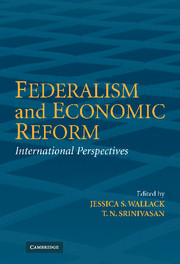Book contents
- Frontmatter
- Contents
- List of Contributors
- Acknowledgments
- 1 Analyzing Federalism: Stylized Models and the Political Economy Reality
- 2 Federalism in Argentina and the Reforms of the 1990s
- 3 Australia: Central Fiscal Dominance, Collaborative Federalism, and Economic Reform
- 4 The Brazilian Federation: Facts, Challenges, and Perspectives
- 5 Changing with the Times: Success, Failure, and Inertia in Canadian Federal Arrangements, 1945–2002
- 6 Fiscal Federalism and Economic Reform in China
- 7 Indian Federalism, Economic Reform, and Globalization
- 8 Mexico's Decentralization at a Crossroads
- 9 Transfer Dependence and Regional Disparities in Nigerian Federalism
- 10 Conclusions and Lessons for Further Study
- Index
- References
7 - Indian Federalism, Economic Reform, and Globalization
Published online by Cambridge University Press: 25 July 2009
- Frontmatter
- Contents
- List of Contributors
- Acknowledgments
- 1 Analyzing Federalism: Stylized Models and the Political Economy Reality
- 2 Federalism in Argentina and the Reforms of the 1990s
- 3 Australia: Central Fiscal Dominance, Collaborative Federalism, and Economic Reform
- 4 The Brazilian Federation: Facts, Challenges, and Perspectives
- 5 Changing with the Times: Success, Failure, and Inertia in Canadian Federal Arrangements, 1945–2002
- 6 Fiscal Federalism and Economic Reform in China
- 7 Indian Federalism, Economic Reform, and Globalization
- 8 Mexico's Decentralization at a Crossroads
- 9 Transfer Dependence and Regional Disparities in Nigerian Federalism
- 10 Conclusions and Lessons for Further Study
- Index
- References
Summary
India is a Union of States based on the framework of cooperative federalism. Within the cooperative framework, there is also a requirement to develop competitive strengths for the States so that they can excel at the national level and the global level. Competitiveness helps in ensuring economic and managerial efficiency and to be creative to meet new challenges. These are essential to survive and prosper in a fast changing world of today. In addition, in order to strengthen democratic processes and institution, we should all truly strive for substantive decentralization.
From the speech by Dr. A. P. J. Abdul Kalam on his assumption of office as President of India New Delhi, 25 July 2002INTRODUCTION
In this chapter we examine the interaction between globalization and India's federal system, in the context of the country's past decade of economic reform. In doing so, we recognize that the national government has subnational governments below it and that all these layers of government simultaneously interact with foreign governments and corporations in a global economy. These multiple interactions have become more important as reform in India has opened up the economy to foreign trade and investment, They have also reduced certain constraints on subnational governments. Globalization provides challenges as well as opportunities to federal systems such as India's. This chapter seeks to elucidate these and to draw implications for policy and institutional reform.
In economic terms, globalization can be taken as the increased international mobility of goods, capital, labor, and knowledge.
- Type
- Chapter
- Information
- Federalism and Economic ReformInternational Perspectives, pp. 301 - 363Publisher: Cambridge University PressPrint publication year: 2006
References
- 16
- Cited by



